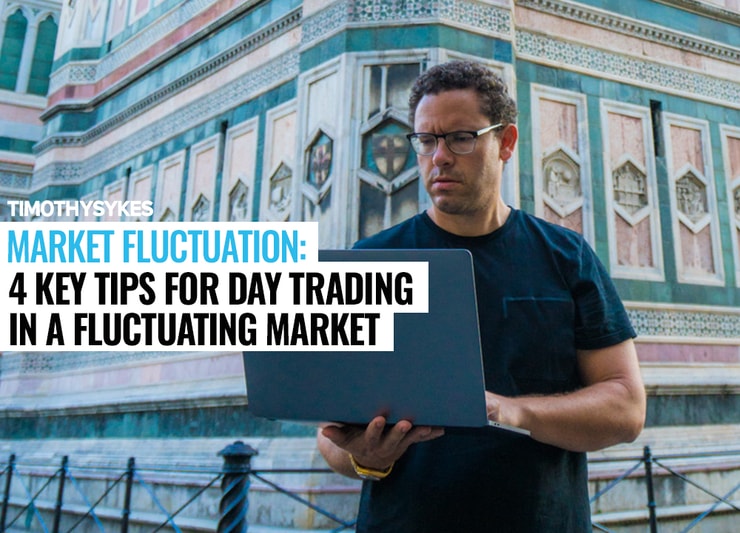Understanding market fluctuation is among the top keys for day trading.
Markets are always going up and down. If the stock market trends up over time, it’s called a bull market. If it trends down, it’s called a bear market. But for a day trader, you need to understand market fluctuation at a much deeper level.
- What makes markets fluctuate?
- Why do stocks break out or break down?
- How do news and psychology affect the stock price?
If you’re going to be successful as a day trader, you need to ask questions like these and do some research.
In this brief guide, I’ll explain the concept of stock market fluctuations and give you four key tips for day trading in a fluctuating market.
Table of Contents
What Is Market Fluctuation?
To understand stock market fluctuations you first need to define ‘the market.’
The big picture: The market is all the different securities sold on any given exchange.
When you see news headlines like “Dow Plunges 1700 Points!” you’re only reading about a very limited number of stocks. When the financial news anchor says “the markets continued to fall today …” they’re talking about stock indexes.
Stock indexes are groups of stocks, like the Dow Jones Industrial Average or S&P 500, that help track overall market trends and sentiment. But the numbers for the index don’t describe individual stock prices. If an index is down for the day, it doesn’t mean every stock has gone down in price.
When you talk about market fluctuation, there’s general market fluctuation. That’s the indexes. But there’s also specific market fluctuation as applied to an individual stock. As a penny stock trader, that’s what I focus on.
The definition of market fluctuation according to Defined Term is “the rise or fall in a security’s price or portfolio’s value within a short-term period; may be slight or dramatic depending on market and other conditions.”
Why Does the Stock Market Fluctuate?
At the most basic level, stock market fluctuations are a matter of supply versus demand.
Supply is the number of shares available and demand is the willingness for someone to pay a certain price. When there are more buyers than sellers, the price goes up. When there are more sellers than buyers, the price goes down.
There are underlying reasons why there might be more buyers or sellers at any given time — and this is super important if you want to be a day trader.
Understanding why stock prices go up and down can potentially help you make better trades. And making better trades can potentially help you be more profitable more of the time.**
What Makes Stocks Go Up and Down?

The good news is, once you know what causes the market to fluctuate, you have a good understanding of what makes individual stocks go up and down. The underlying indicators are often the same.
For example, big news events can create huge market fluctuations. Dial that down to individual stocks and you’ll see that worldwide news, sector or industry news, and company news all impact share prices.
When you go open your trading software, the current share price reflects daily stock price fluctuation. But that doesn’t mean the price on your screen is what you’ll pay if you buy 1,000 shares in the next five minutes.
To better understand how it works, here’s a brief description of bid, ask, and spread. Study this, because it can potentially make a big difference for your trades.
More Breaking News
- BigBear.ai’s Journey in the Stock Market: Rising Trends and Challenges
- Top Bitcoin Stocks to Watch Under “Crypto Emperor Trump”
Bid
Bid is like making an offer on a house. For example, say you go view a house. You know what the seller is asking for the house. You decide you like the house and make a bid — an offer based on everything you know about the house and the market.
Say you know there’s an issue with the plumbing and the owner has done a nice job hiding it with a little cosmetic DIY. You offer lower than the asking price because you know it will cost you both dollars and time to get it fixed.
Bid price is the same idea in the stock market. It’s an offer made by a trader or investor to buy a certain number of shares at a particular price.
Now, as a penny stock day trader, I’m not looking at the plumbing — I’m looking at my charts, the catalyst behind the stock price move, ease of entry and exit, and other criteria.
But at some point, if I decide it’s a good trade, then I make a bid.
Ask
Back to our house example. Let’s say the seller of the house wants a certain amount of money for the house. It might not be exactly in line with your offer. But since you made an offer, the seller has to decide if they’re willing to take it.
In the stock market, an ask price is what the seller is willing to accept for a security. Like the bid, there’s often a specific number of shares associated with the ask. In other words, the seller is willing to sell x number of shares at y price.
The terms bid and ask are used in every market — from forex to bonds, stocks, and derivatives such as futures and options.
Spread
The spread is the difference between the bid and ask prices of a stock. For example, let’s say you want to open a small position, say, 1,000 shares of Company Q. You’re willing to pay $1 per share. But the ask price on the market when you make the trade is $1.10 per share. The spread is 10 cents.
Why is this important to you? The spread can make what seems like a good setup into a not-so-good setup. See, the spread is determined by supply and demand — just like the price.
When there’s high trading volume — meaning you can get in and get out of a trade much easier — then the spread narrows.
But if volume drops then you might be stuck in a position. You could be caught trying to buy or sell at the wrong price. Then you might have to adjust your ask or bid price to execute the trade.
4 Key Tips for Day Trading in a Fluctuating Market

Now that you have a better understanding of stock market fluctuations, I’ll get right to the four key tips. These tips can help you as you do your research for stocks on your watchlist.
Tip #1: Don’t Trust Stock Promoters
When it comes to penny stocks, big market fluctuations often happen because of stock promoters.
These are the marketing companies behind stock pump schemes. They get traders to sign up for their email lists and then pump up whatever stock they’ve been paid to pump.
There was a time when you could make a lot of money on pumps. You could just ride the pump when the news broke. But the game has changed and now you don’t know if the news was sent out to several email lists. In other words, you might be on email list number 10 instead of number one, and lose big because you buy into something that’s already played out.
If you read the disclaimers in their promotions, they blatantly tell the truth — so don’t be one of the dumb people who doesn’t read the disclaimer.
Some of them even come out and say the promotion is for penny stocks and the volume and price will likely increase during the promotion. They tell you straight up that if you buy and hold past the promotion, you’re likely to lose all your money!
The point I’m trying to make here is this: Don’t trust the stock promoters. They promote the stocks they’re paid to promote. And they tell you exactly that if read the disclaimer.
If you want to research the stocks they’re pumping, go ahead … but don’t trust them because you’ll get burned. I recently made a video exposing the most blatant penny stock promoter right now. Check it out. Learn.
Tip #2: Pay Attention to New Catalysts
The stock market isn’t an exact science. Reading and deciphering market fluctuation is almost an art. But if you put in the time to understand all the moving parts, then trading in the market might be a good place for you.
When watching a stock, you should always pay attention to new catalysts.
- Is there a positive earnings report?
- Did the company sign a deal with a large, well-known company?
- Is there some new product or service announcement?
Did the company announce at 4 p.m. on a Friday that it will be in the news over the weekend? Will it be good news or an exposé on a company scandal? These are all catalysts and they’re the types of things you should look for.
Other catalysts might be sector news, like, for example, the recent cannabis stock news. Cannabis companies have been in the news a lot due to Canada legalizing pot for recreational use. This type of news helps stimulate market fluctuation. Sometimes you get so-called sympathy plays from these kinds of catalysts.
Tip #3: Use Stock Analysis Technique Before Trading

Never, ever go into your trades without doing research, which includes stock analysis.
So many newbie traders look at one or two things and then make a trade with incomplete information. They latch on to the few things they think are important or exciting, only to miss some piece of the puzzle that would have kept them from making a bad play.
For example, let’s say you put a stock on your watchlist because it was a big percent gainer. Then you think it might be a possible trade because you found some news — a catalyst — behind the big gain. Well, that’s good but it’s not enough information to take a position!
What do you do next? How can you tell if the price move has legs? You use a stock analysis technique to determine if it’s a possible play. You need to learn technical analysis of stocks. Like I said before, it’s not an exact science. But there are things to look for.
I explain them in detail with some good examples in my Trader Checklist resource. There you’ll find my seven criteria for ranking a stock from seven to 100 before you make a play. Go watch those videos and take notes.
Tip #4: Improve Your Stock Market Skills
I can’t repeat this enough: Long-term success in trading comes from a continuous desire to learn more.
You have to keep learning and refining your knowledge and experience. You can’t expect to get rich following some stock promoter’s tips or even following some trading teacher’s tips.
That’s why my teaching goal is to help my students become self-sufficient traders. Some of them become much better traders than me — and I’m totally happy with that. I want you to become a better trader than I so I can retweet your tweets about profitable trades. Nothing makes me happier!
Whatever you do, never stop learning. Keep studying. I know I harp on about this. That’s because it’s so important and possibly the only way you’ll get to achieve your loftiest financial goals.
Trading Challenge
If you’re reading this post, I assume you’re serious about making money.
Maybe you’re interested in generating five or six figures a year so you can enjoy the laptop lifestyle for the rest of your days. Or perhaps you’re committed to generating at least $1 million in profits from the stock market.
My students come from all walks of life, and each has individual goals. Everyone is working for something, though, and I teach my students to visualize their ideal lifestyle while they’re learning from me and other successful traders.
My Trading Challenge offers a community of like-minded people who help each other achieve their goals. It’s not just me in the trenches. When you know there are other people striving for the same things you want, you’ll have greater motivation to work hard.
If you want to create a different life for yourself, I invite you to apply for the Challenge. I’m looking for my next success story, and you might become that person if you’re willing to put in the effort.
The Bottom Line
Market fluctuation is part of the game. For a penny stock day trader, it’s a good thing as long as you arm yourself with knowledge.
Study — keep studying — and you’ll begin to understand the underlying factors that cause markets to fluctuate. Armed with this knowledge, you can potentially be better prepared for the stock market battlefield.
Are you already a trader or are you just getting started? Is the market as brutal as I make it out to be? Leave a comment below.





Leave a reply